Dibs On Stuff
(for free)
Take Turns Without Talking to People:
3 Slack Apps Compared
Hand-written by Alex Lance, 1st August 2025
3 Slack Apps Compared
Hand-written by Alex Lance, 1st August 2025

Isn't it always the way: you want to use the staging server to test some code
changes, but someone else is using it. If only there were a quick way to take
turns without all that messy "interacting with people".
This article provides an overview of the best queuing apps in the Slack marketplace. Who will come out on top? Well, spoilers: maybe that "Dibs" one isn't too shabby - but I'll try to provide a fair overview of the three.
This article provides an overview of the best queuing apps in the Slack marketplace. Who will come out on top? Well, spoilers: maybe that "Dibs" one isn't too shabby - but I'll try to provide a fair overview of the three.
1. Dibs On Stuff
https://dibsonstuff.com
https://dibsonstuff.com
Created in 2020 to help my team take turns with staging servers, Dibs grew
and grew and (eventually) became a splendid example of what you really can achieve
with idle hands.
Here's the help info that pops up when you run
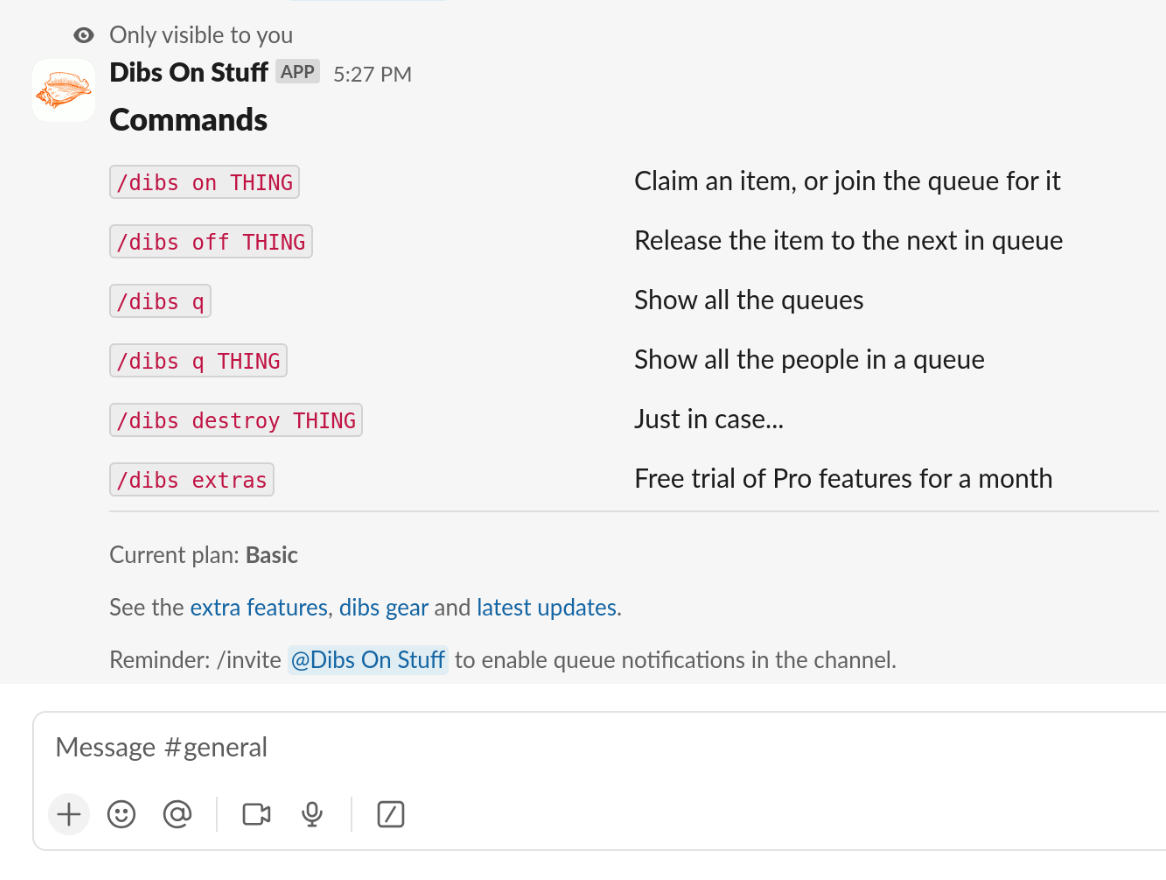
There's no manual initialization of queues required, you just try and claim a thing (eg the staging server) with a Slack command like
Now if that's all you're looking for, then head over to Dibs to install it (for free) and don't look back. Especially don't look at the rest of this article that introduces the competitors.
If you want a little more from Dibs, then maybe some of the paid features will wet your whistle, for example:
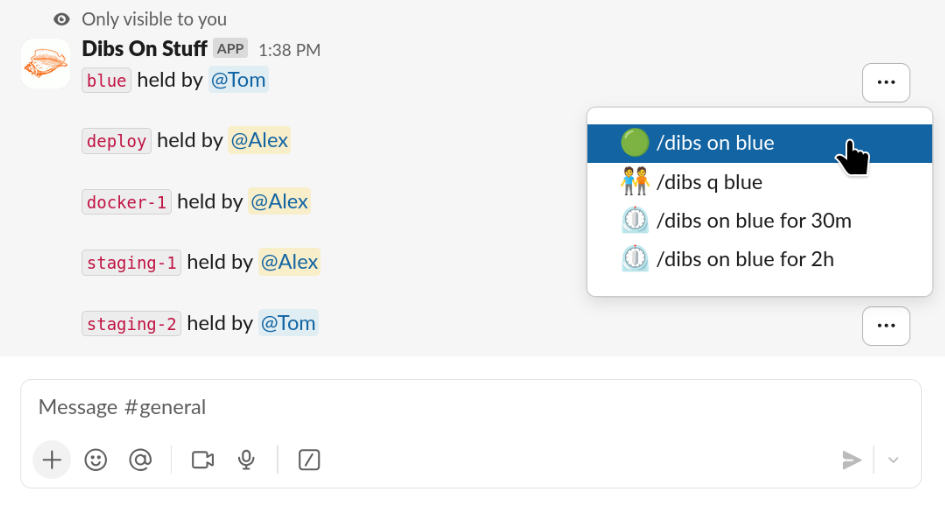
You can configure particular queues to require timers, ensuring a timely exchange. Or customize the noise level of the alerts, so that some queues get your attention and some queues proceed quietly. Small notes can also be attached as required, eg:
And one can manually jump to the front of the queue or bump someone else off the queue if necessary (dibs on and dibs off, have corresponding force-on and force-off commands).
There's a webhook builder for building out random integrations that should get triggered when the queue moves, and the whole thing is controllable via API in case you need to connect Dibs to your other systems.
Pricing
Here's the help info that pops up when you run
/dibs but
most of the time all you need is: "dibs on" and "dibs off".

There's no manual initialization of queues required, you just try and claim a thing (eg the staging server) with a Slack command like
/dibs on staging and if it's
available, then it's all yours. If someone else is
using it, you'll get queued up and then notified when it becomes free.
Now if that's all you're looking for, then head over to Dibs to install it (for free) and don't look back. Especially don't look at the rest of this article that introduces the competitors.
If you want a little more from Dibs, then maybe some of the paid features will wet your whistle, for example:
/dibs on staging for 20m will claim
the staging server and automatically/non-interactively unclaim it again 20
minutes later (if typing long commands is annoying, there's also a handy
overflow menu).

You can configure particular queues to require timers, ensuring a timely exchange. Or customize the noise level of the alerts, so that some queues get your attention and some queues proceed quietly. Small notes can also be attached as required, eg:
/dibs on staging because issue #322.
And one can manually jump to the front of the queue or bump someone else off the queue if necessary (dibs on and dibs off, have corresponding force-on and force-off commands).
There's a webhook builder for building out random integrations that should get triggered when the queue moves, and the whole thing is controllable via API in case you need to connect Dibs to your other systems.
Pricing
- Dibs is free up to 5 queues, no limits or restrictions.
- $29 per month up to 20 queues + all the Extra Plan features.
- $99 per month for unlimited queues + the full suite of Pro functionality including API access, merch gifts and flexible configuration options.
2. Queue by Ubots
Queue
Queue
The fine folk at Ubots have created an app named "Queue". Unlike Dibs, it
provides a one queue per-channel approach. Team members can join and leave the
queue as they like, and the free plan allows each queue to have a maximum of three
members in line.
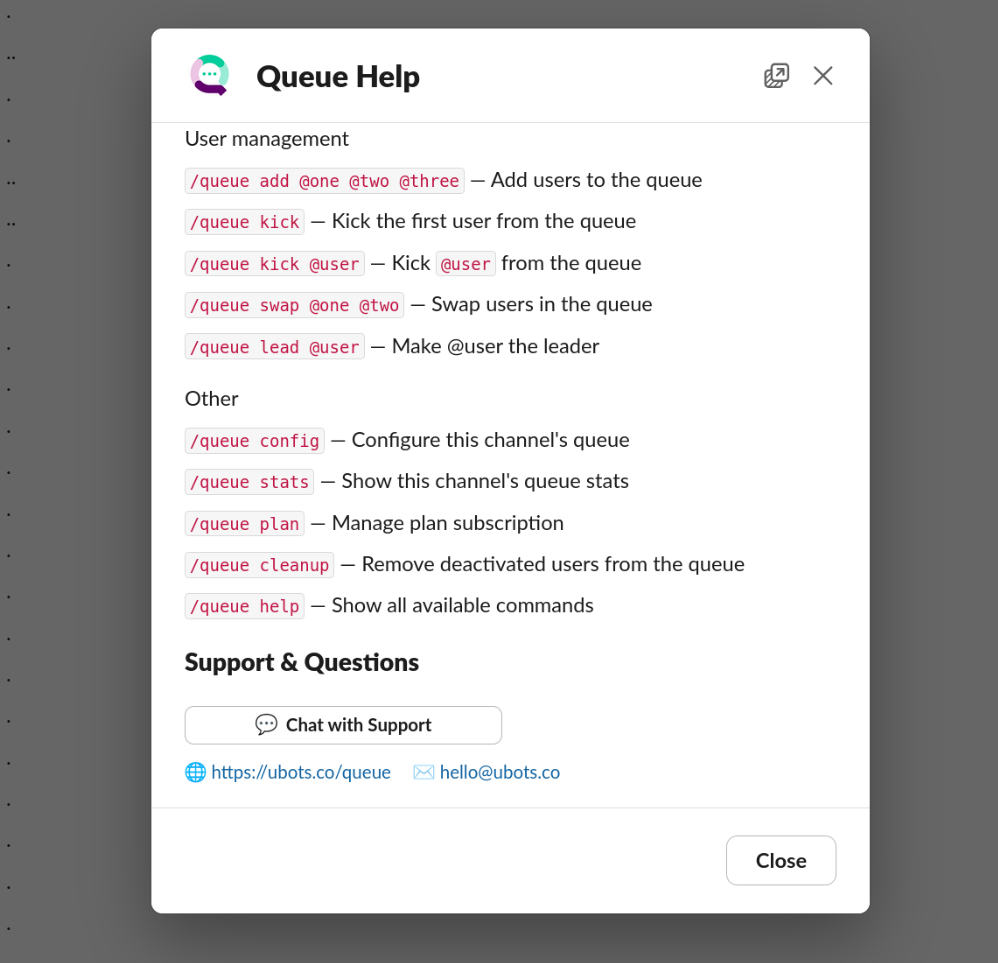
There is a paid plan that will let you manage your queue in various ways, including: setting a leader timeout, status messages and per-user permissions.
Queue does what it says on the box, but the free plan can be fairly restrictive. The one queue per-channel model is a choice that will impact the way you interact with multiple queues (however it's less of an issue if you're already using a separate Slack channel for each queue).
The user-interface is very intuitive with big clear buttons to Join or Leave a queue, and a handy popup window for accessing their paid features.
The timeout duration is a per-queue setting. I was a little surprised this wasn't more customizable. I.e. different people might need different amounts of time, rather than (eg) 1 hour and you're booted off.
Pricing

There is a paid plan that will let you manage your queue in various ways, including: setting a leader timeout, status messages and per-user permissions.
Queue does what it says on the box, but the free plan can be fairly restrictive. The one queue per-channel model is a choice that will impact the way you interact with multiple queues (however it's less of an issue if you're already using a separate Slack channel for each queue).
The user-interface is very intuitive with big clear buttons to Join or Leave a queue, and a handy popup window for accessing their paid features.
The timeout duration is a per-queue setting. I was a little surprised this wasn't more customizable. I.e. different people might need different amounts of time, rather than (eg) 1 hour and you're booted off.
Pricing
- Free plan allows for unlimited queues (but at most 3 queue members).
- Paid plan is $5 per-month, per 50 users.
3. StagingApp by Arzawan
StagingApp
StagingApp
This app shows lots of promise, although it doesn't strictly manage queues per se, but
rather the claiming and releasing of (staging) environments as a one-shot operation.
You must create the relevant queue before being able to claim it. There is also a "request" command which can be used to indicate interest in a queue (although perhaps a direct message to the queue holder would fill the same function).
It has a mostly text-based interface, but there are a few rough edges, eg: one of the buttons I clicked didn't appear to do anything, and the error messages could be a little more helpful than "invalid input".
The listing of environments feels a bit clunky with
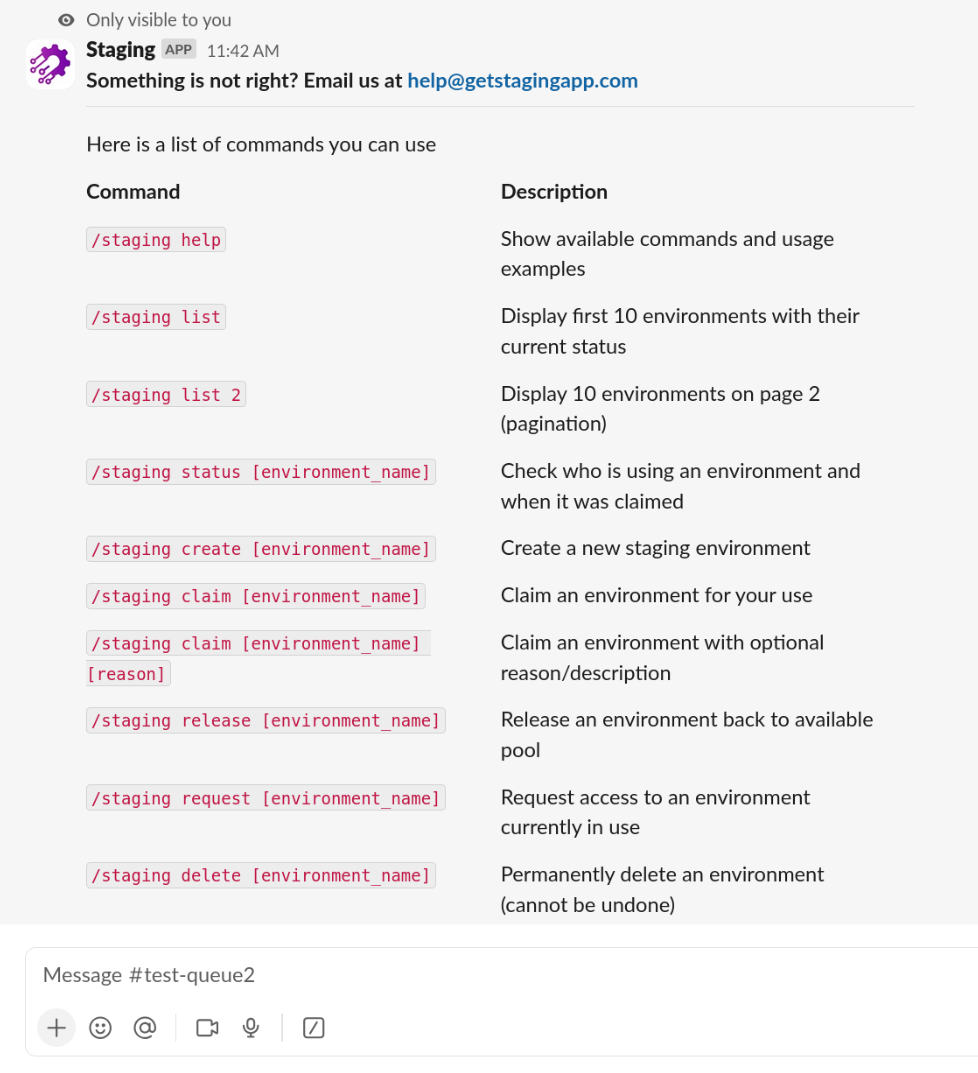
StagingApp has an in-Slack home screen that is helpful for providing queue information at a glance and providing useful shortcut buttons for configuration: Setting a timeout (they call it a "Usage limit") and configuring the Slack notification channels.
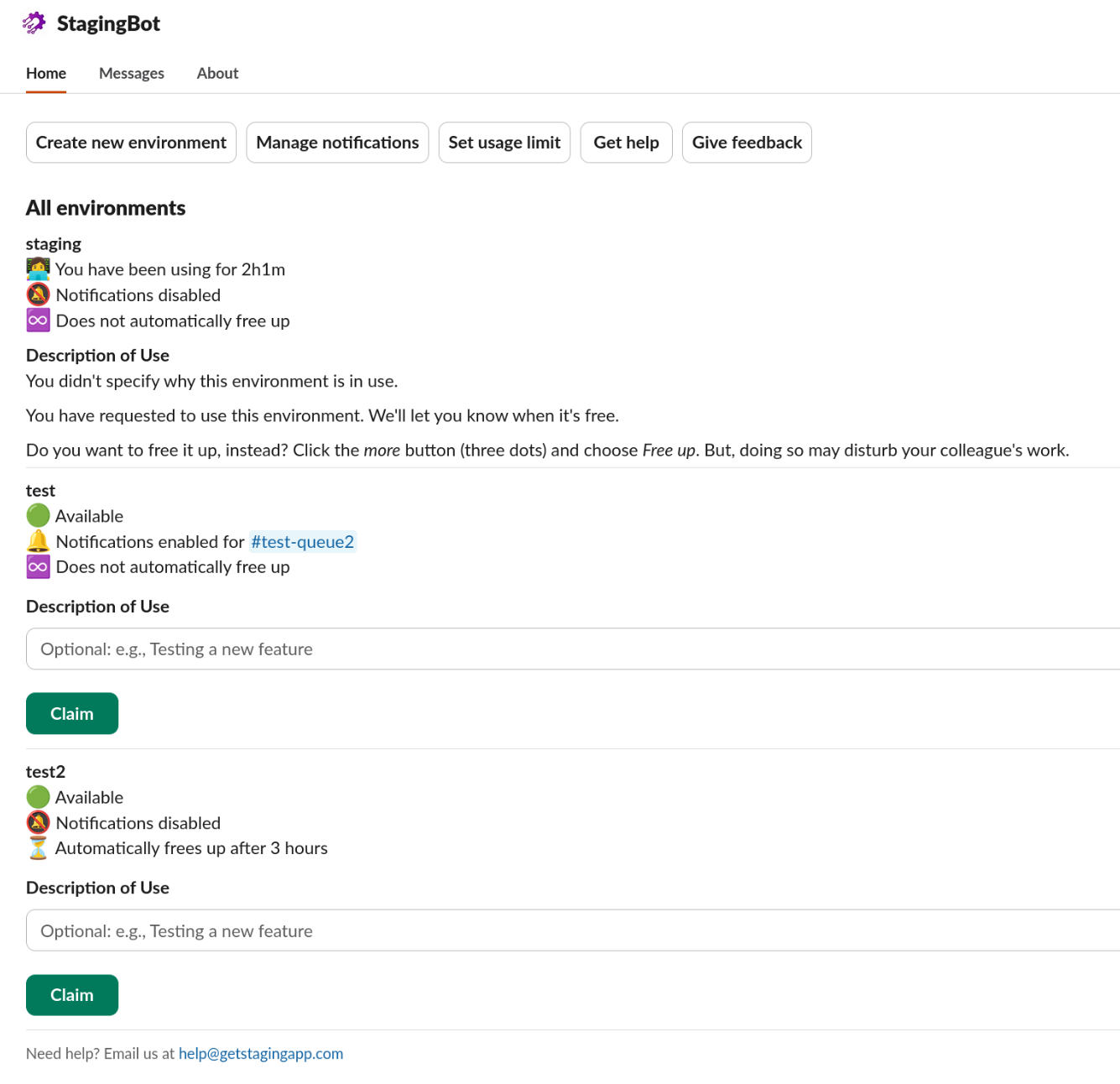
Running
Pricing
You must create the relevant queue before being able to claim it. There is also a "request" command which can be used to indicate interest in a queue (although perhaps a direct message to the queue holder would fill the same function).
It has a mostly text-based interface, but there are a few rough edges, eg: one of the buttons I clicked didn't appear to do anything, and the error messages could be a little more helpful than "invalid input".
The listing of environments feels a bit clunky with
/staging list 1
and /staging list 2 (and so on) for pagination. And I suspect the main
help screen could be made a little simpler.

StagingApp has an in-Slack home screen that is helpful for providing queue information at a glance and providing useful shortcut buttons for configuration: Setting a timeout (they call it a "Usage limit") and configuring the Slack notification channels.

Running
/staging request environment sends a message to the
person holding the queue/environment, asking them if they'd like to release the
item, but (oddly) it doesn't tell them *who* is making the request.
Pricing
- Free plan allows 2 environments
- Paid plan $1.99 per-month, per-user
- Enterprise pricing available
Summary
I'm sure this doesn't come as a huge shock to hear this from me, but
if you prioritize simplicity and configurability: Dibs On Stuff has some
clear advantages.
It can be adjusted to your workflow and has queue configuration that is there when you need it (and stays hidden when you don't).
Importantly, multiple queues can co-exist across one or more channels, and there aren't any restrictions on the number of queue members in our plans.
The pricing model is tiered fairly for small companies and large. You're not going to get surprised with an auto-scaling invoice because more people used the app that month.
Dibs is fast and intuitive, and will help your team work together efficiently without the repetitive Slack chat - so that (hopefully) more valuable conversations can be had.
< Home
It can be adjusted to your workflow and has queue configuration that is there when you need it (and stays hidden when you don't).
Importantly, multiple queues can co-exist across one or more channels, and there aren't any restrictions on the number of queue members in our plans.
The pricing model is tiered fairly for small companies and large. You're not going to get surprised with an auto-scaling invoice because more people used the app that month.
Dibs is fast and intuitive, and will help your team work together efficiently without the repetitive Slack chat - so that (hopefully) more valuable conversations can be had.
< Home

